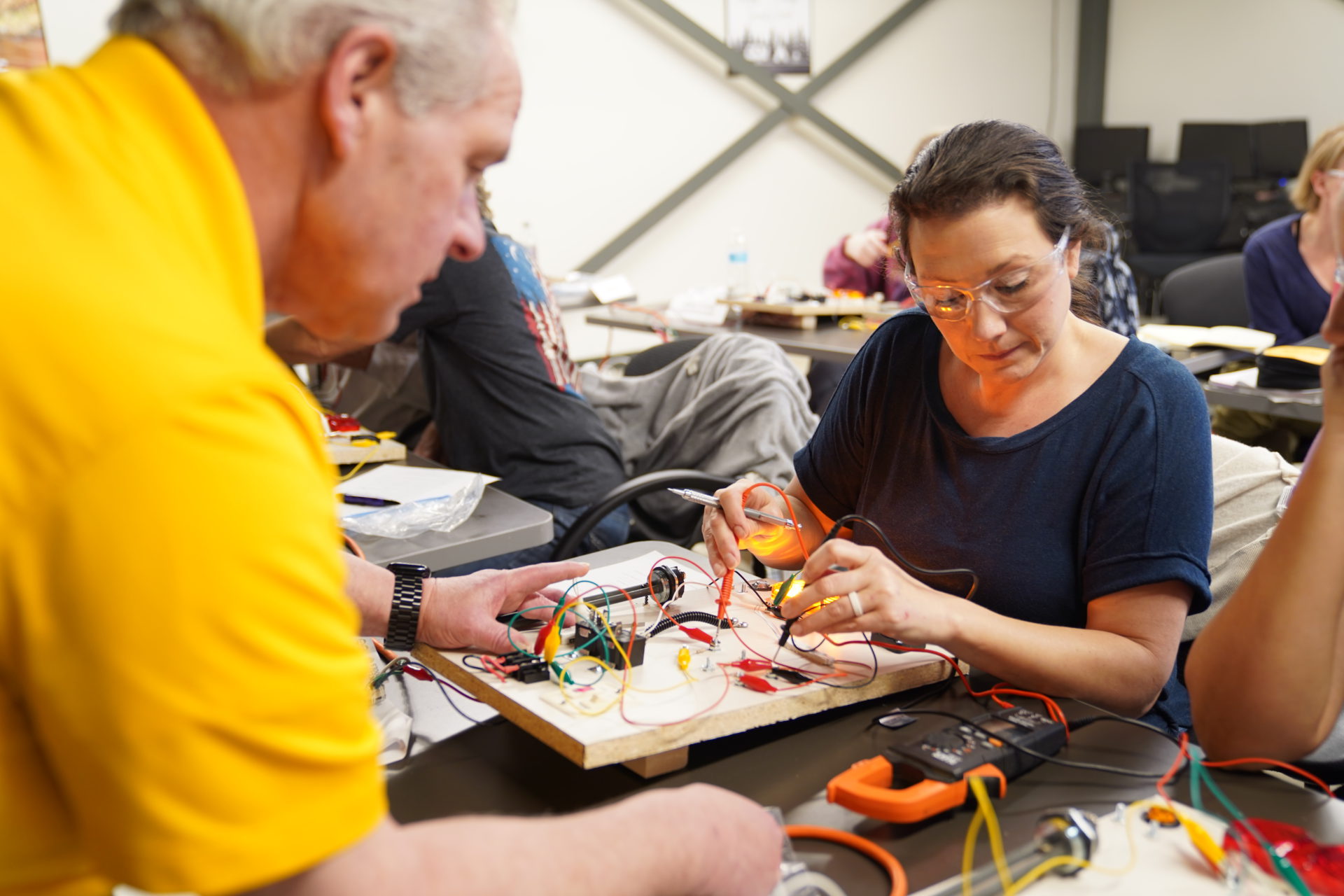
20 unconventional careers for art majors
Posted by
Choosing a college major is a big decision, especially when it comes to the arts. A bachelor of arts (BA) degree might conjure up images of the stereotypical “starving artist” — struggling to pay rent, living in a cramped apartment with three roommates, and barely making ends meet. The pressure to choose a major with a clear, high-paying career path is real, especially given the rising cost of a college education and the expectation of making a significant return on investment.
If you’re gravitating toward the arts, you likely want a job that pays the bills, but also fulfills you. The good news? An arts degree is far from a one-way ticket to financial instability.
Your parents might worry that a liberal arts degree won’t lead to a stable career, but employers see things differently. They know that while technical skills can be taught on the job, the soft skills you learn from a liberal or fine arts education are harder to train. A survey of employers conducted by the Association of American Colleges & Universities found that employers look for oral and written communication skills, critical thinking, ethical judgment, teamwork, and the ability to apply knowledge to real-world situations.
A BA in art is a gateway to a variety of interesting, challenging, satisfying, and lucrative careers. Check out these unconventional career paths where arts majors thrive, proving you absolutely can turn what feeds your soul into a profitable profession.
Alternative and unconventional careers for arts majors
 1. Art director
1. Art director
This creative leader is responsible for the overall visual style and imagery of a project, whether it’s an advertisement, digital magazine, website, movie, or video game. They may not create the art themselves, but they guide and inspire a team of graphic designers, photographers, illustrators, and other artists to bring a vision to life. Art directors develop the “big idea” — the look, feel, and aesthetic of the project — and manage the team and process to keep all visual elements consistent and effective. In marketing, for example, they confirm the colors, fonts, layouts, and images work together to tell a compelling story or sell a product.
 2. Art educator
2. Art educator
An art educator teaches the arts (think visual arts, drama, and music) to students. These teachers work in elementary, middle, and high schools, as well as colleges, universities, and community centers. Their main goal? Fostering creativity, critical thinking, and an appreciation for art. While art educators teach students how to paint or draw, block a scene, or play a new piece of music, they also do so much more! They expose students to art, theater, or musical history, including artists, actors and playwrights, and composers. Art educators introduce students to various styles, movements, and the cultural contexts behind these arts. These teachers help students develop their own unique voices and build problem-solving skills to use throughout their educational journey and beyond
 3. Art lawyer
3. Art lawyer
Art lawyers specialize in legal issues related to the creation, sale, and ownership of art. They work in the intersection of the law and art worlds, helping artists, collectors, galleries, and museums navigate a complex legal landscape. Art attorneys safeguard the rights and interests of all parties involved in the art world. This career path is an excellent way to combine an interest in the arts with a career in law.
 4. Art conservator
4. Art conservator
Art restorers, also known as art conservators, preserve and repair damaged or deteriorating works of art. Their job is to ensure that people can enjoy a painting, sculpture, textile, or historical fact for generations to come. This profession requires someone who’s a combination of an artist, scientist, and detective.
 5. Art therapist
5. Art therapist
These mental health professionals use the creative process of making art to help people explore their emotions, resolve conflicts, and enhance their well-being. Unlike art teachers, art therapists focus on the therapeutic benefits of creation rather than the aesthetic qualities of the art itself. They work with people of all ages and many issues, including trauma, depression, anxiety, and learning disabilities. An art therapist’s work is based on the idea that creative expression can help people communicate feelings and thoughts that might be too difficult to put into words.
 6. Communications director
6. Communications director
A communications director is a senior-level leader responsible for shaping an organization’s voice and public image. They’re the chief storyteller and strategist for a company, nonprofit, college or university, or even a political campaign. While writing comprises a big part of their job, they also create a comprehensive plan for how the organization communicates with the world and its employees.
 7. Digital content manager
7. Digital content manager
Digital content managers oversee all the content an organization creates for its online channels. They’re responsible for the company’s “story” in the digital world, making sure their message is consistent and that the content is engaging, relevant, and reaches the right audience. These strategists blend creative vision with data analysis.
 8. Game designer
8. Game designer
A game designer is the creative mastermind behind a video game. They’re responsible for the game’s overall vision and experience, including the story, characters, rules, and world. Game designers don’t typically do the programming or create all the art themselves. They act as the project lead, collaborating with artists, writers, and programmers to bring their concept to life. This career uses creative and analytical skills in a dynamic, collaborative environment.
 9. Illustrator
9. Illustrator
An illustrator is a professional artist who creates drawings and images to help tell a story or explain an idea. Their primary purpose? Communicating specific messages to (or for) their clients. They can work in many industries, as medical or scientific illustrators, concept artists in the entertainment industry, forensic or courtroom illustrators, technical illustrators in manufacturing, fashion illustrators, and more.
 10. Industrial designer
10. Industrial designer
These professionals design the look, feel, and function of manufactured products. They make sure everyday objects, like smartphones, cars, furniture, or kitchen appliances — anything you can think of, really — are appealing to look at and safe, easy to use, and cost-effective to produce. Their work blends art, science, and engineering, mixing creativity with practical problem-solving to improve the objects we interact with daily.
 11. Interior designer
11. Interior designer
Interior designers create functional and aesthetically pleasing interior spaces for homes, offices, and other buildings. They don’t just decorate. They’re trained to plan layouts, choose materials, and manage projects to ensure spaces are beautiful, safe, and practical. These professionals combine art, architecture, and psychology. They understand how colors, lighting, and textures affect a person’s mood and productivity and use that knowledge to create functional and inspiring spaces.
 12. Multimedia artist
12. Multimedia artist
Multimedia artists create and manage digital content for platforms like websites, social media, presentations, and interactive applications. They’re experts at blending various types of media, like text, images, audio, video, and animation, to create engaging, informative experiences. They’re the jacks-of-all-trades in the digital world, combining creative vision with technical skills and a great fit for people who are artistically inclined and tech-savvy.
 13. Naval architect
13. Naval architect
These engineers design and oversee the construction of ships, boats, submarines, and other marine vessels and structures. Naval architects combine a knowledge of engineering, physics, and design to ensure vessels are safe, efficient, and able to withstand the forces of the ocean. It’s a great career for someone interested in creative design and complex problem-solving. Naval architects work on a wide range of projects, from large cargo ships and cruise liners to military vessels, yachts, and floating oil platforms.
 14. Product designer
14. Product designer
These creative problem-solvers design the look, feel, and functionality of physical and digital products. They’re artists, but also researchers, strategists, and analysts focused on creating products that are appealing, useful, and fun to use. Their main goal? Making products that solve real user problems and meet business goals. Product designers are involved in every stage of a product’s life cycle, from conceptualization to launch and beyond.
 15. Production artist
15. Production artist
A production artist handles the final, technical steps of a design project before it’s printed or digitally published. While a graphic designer or art director comes up with the initial creative concept, a production artist ensures the artwork is perfectly prepared and ready for production. They’re the detail-oriented perfectionists of a creative team.
 16. Sound technician
16. Sound technician
Sound technicians work with audio equipment to deliver clear, balanced, high-quality sound for audiences. They're the behind-the-scenes experts at a concert, in a recording studio, on a movie set, and in the theater, controlling everything from the volume of a singer's mic to a film's specific audio effects. It's an excellent fit for students with an ear for music and a knack for technology, as this career blends technical expertise with creative problem-solving.
 17. UI/UX designer
17. UI/UX designer
A UI/UX designer creates the user experience and user interface for digital products like websites and apps. They ensure the product is easy and intuitive to use (UX) and visually appealing and well-designed (UI). While often grouped, UX and UI are two distinct but interrelated parts of the same process. Think of a car: A UX designer would make sure the car’s controls are logically placed and comfortable to use. A UI designer would choose the colors, fonts, and button styles on the dashboard.
 18. Videographer
18. Videographer
A videographer shoots and edits video to tell a story or capture an event. Unlike a director on a big-budget film or television set, a videographer is often a one-person crew, handling everything from setting up the camera and lighting to recording the audio and editing the final product. Videographers are the go-to people for creating content for weddings, corporate training videos, marketing campaigns, documentaries, museum displays, and more.
 19. Visual merchandiser
19. Visual merchandiser
Visual merchandisers design and arrange retail displays to attract customers and increase sales. They create the in-store experience, from designing the storefront window to arranging products on the shelf. Their goal? Telling a story with a brand’s products, making them appealing and easy for customers to find. This career blends art, psychology, and marketing.
 20. Web designer
20. Web designer
These professionals create the look, feel, and functionality of websites. Web designers are responsible for a site’s visual appearance and UX. While web developers write the code that makes a website function, a web designer focuses on how a user will interact with the site, making sure it’s visually appealing, easy to navigate, and consistent with the brand identity.
Blog Categories
- Career Advice
- College Admissions
- Colleges & Universities
- Financial Aid and Scholarships
- For Counselors
- For Parents
- For Students
- Gap Years
- Mental Health and Wellness
- Online Learning
- Performing and Visual Arts
- STEM Majors and More
- Summer Programs
- Teen Volunteering
- Trade & Vocational Schools
- Tutoring & Test Prep

Organization with listings on TeenLife? Login here
Register for Free
We’re here to help you find your best-fit teen-centered academic and enrichment opportunities.
Forgot Password
"*" indicates required fields

 1. Art director
1. Art director 2. Art educator
2. Art educator 3. Art lawyer
3. Art lawyer 4. Art conservator
4. Art conservator 5. Art therapist
5. Art therapist 6. Communications director
6. Communications director 7. Digital content manager
7. Digital content manager 8. Game designer
8. Game designer 9. Illustrator
9. Illustrator 10. Industrial designer
10. Industrial designer 11. Interior designer
11. Interior designer 12. Multimedia artist
12. Multimedia artist 13. Naval architect
13. Naval architect 14. Product designer
14. Product designer 15. Production artist
15. Production artist 16. Sound technician
16. Sound technician 17. UI/UX designer
17. UI/UX designer 18. Videographer
18. Videographer 19. Visual merchandiser
19. Visual merchandiser 20. Web designer
20. Web designer






